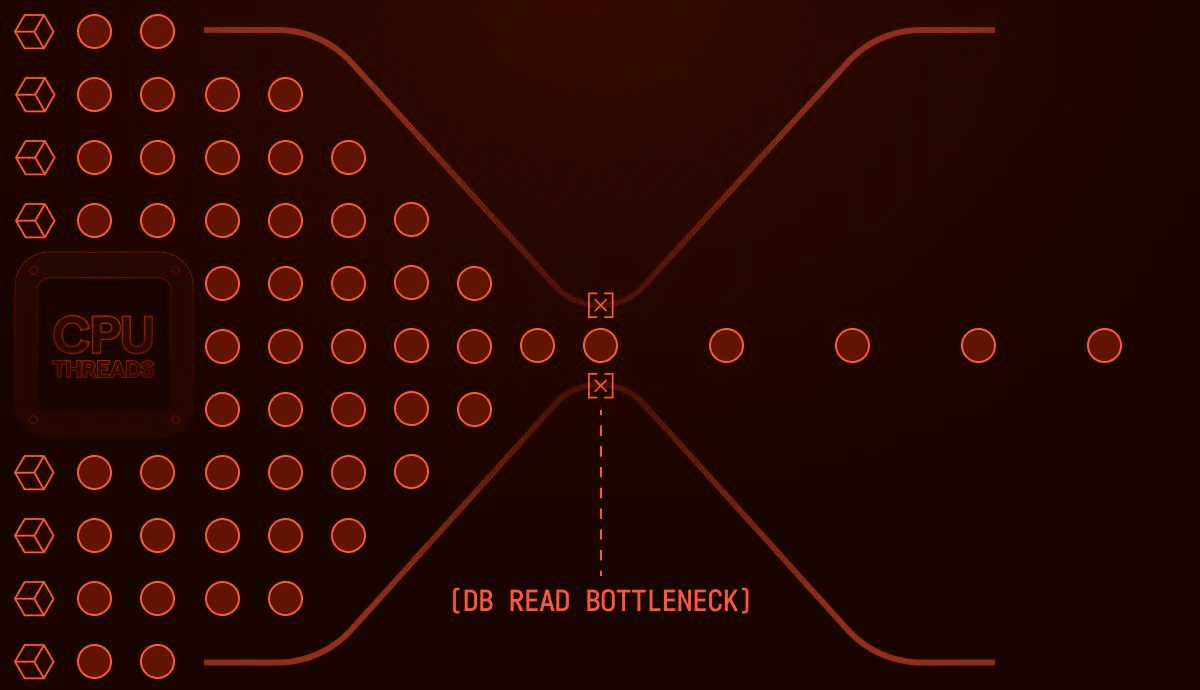Hello everyone! As a developer who has been immersed in the Web3 world, from building DeFi dApps on Ethereum to scalable backends in Web2, I can’t help but empathize with the recent tweet from Altius Labs.
They describe: "Most blockchains run on modern hardware, but their database access is still stuck in 2008. Imagine 8 CPU cores trying to sip water through a tiny straw. That’s the situation when there’s no concurrent database reading."
This image is awesome! It clearly illustrates the bottleneck that is killing blockchain performance. Today, I want to share my perspective, combining experiences from Web2 and Web3, to analyze this issue. We will explore why blockchain still lags behind in database technology, and how modern solutions like modular execution layers can change the game.

Lessons on Concurrent Access
First, let’s rewind to Web2 – the world where I started my career. In traditional databases (like SQL with Postgres or NoSQL with ScyllaDB), reading data concurrently is the norm. You can query data across multiple threads, maximizing multi-core processors for lightning-fast speeds. No congestion – your application scales horizontally, handling thousands of reads per second without breaking a sweat. That’s why e-commerce sites or social networks don’t crash under heavy load.
ScyllaDB, for example, is a NoSQL database designed for high throughput, and it’s even used in some blockchain projects like IOTA's Tangle – a DAG (Directed Acyclic Graph) model that eliminates linear chains to allow for parallel bonding, reducing bottlenecks and transaction fees. In Web2, we solved this issue with sharding, caching, and optimistic concurrency control – techniques that help applications run smoothly on modern hardware.
But what about Web3? Blockchain is a whole different beast. Unlike centralized databases, blockchain is a distributed ledger: immutable, cryptographically secure, and based on consensus (PoW or PoS). This is great for trustless systems, like NFTs or DeFi. However, this distribution brings enormous challenges – especially scalability and concurrent access.
The core issue: Sequential Processing And Bottleneck
Most blockchains process transactions sequentially to maintain determinism and security. Consensus requires all nodes to agree on state changes, so reading/writing the database is serialized. The result? Even on a 64-core server, you still only use one "straw" for data access. High-load events (like token launches) cause congestion, fees spike, and delays extend. It’s like single-threaded applications from the early 2000s – inefficient on today’s hardware.
Imagine this: Your computer has 8 CPU cores, but the blockchain only uses one core to read the database. The other cores... are just idle! This is why Ethereum faced congestion crises before rollups, or why Solana sometimes "hangs" under heavy load.
What Is The Solution?
From our Web2 experience, we know concurrency is key. Why not apply it to blockchain? Some projects have done this: Solana with Sealevel VM analyzes account access for parallel processing, or Aptos/Sui with Move VM supporting parallelism. But to go broader, we need modular solutions.
This is where Altius Labs shines. With a modular execution layer, they separate execution from consensus, allowing parallel reading of the database and instruction-level parallelism. The idea: Analyze transaction dependencies first, then process non-conflicting operations simultaneously. This leverages idle CPU cores, increasing TPS by 10x+ without sacrificing security. As a dev, I see this as a game-changer for building real-time dApps – from gaming to SocialFi.
Moreover, combined with Web2 techniques like NoSQL scalability, Web3 can achieve performance on par with Web2. Projects like Ethereum rollups or Altius’s VM-agnostic framework are paving the way. If you’re a dev, try writing smart contracts optimized for parallelism – saving gas is already worth it!
Challenges
Of course, not everything is perfect. Consensus is still energy-intensive, regulatory issues are a barrier, and retrofitting old chains is complex. But by combining concurrency from Web2 with the distribution of Web3, we are heading towards a seamless future. Forget L1 vs L2 – modular design will lead the next generation of Web3.
Upgrade or forever congested?
In summary, blockchain needs to upgrade its database game, or it will remain stuck at the bottleneck. Web2 has taught us about concurrency; Web3 must apply it to survive. What do you think about chain performance? What’s your biggest pain point? Please comment below! 🚀
If you’re interested, follow Altius Labs for updates on advanced solutions. #Web3Dev #BlockchainScalability #AltiusLabs
(Reference: Documentation from ScyllaDB and Altius Whitepaper. The article is based on personal experience and is not investment advice.)
